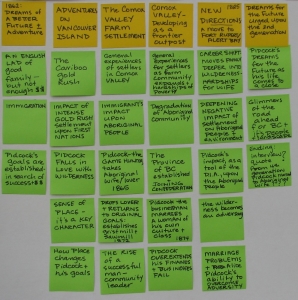Getting Set to Write is Like Packing for a Trip
Outlining Methods – Part II
Here’s some ideas for writers who prefer to use basic structures for organizing their research and ideas as they get set to write a family history, biography or memoir. This offers a light approach to the process described in last week’s blog about more complex forms of outlining: http://thescribes.ca/how-to-get-organized-to-write-part-i/
Some might describe what’s offered here as “organic” outlining methods (see the Writer’s Digest article Go Organic http://www.writersdigest.com/online-editor/6-secrets-of-writing-a-novel-without-an-outline). I use what I call a “chronological list” to wrestle my research material into a cohesive summary, and a “subject sketch” to get a sense of the salient details and storytelling elements (readers like to follow one or more main characters’ lives and some conflict and resolution). I sometimes also use mind mapping to get a better sense of specific character’s personalities and history.
Three Easy Ways to Create an Outline For Your Book:
• A chronological list is a point form reckoning of the important events. It gives you an overview and highlights info gaps and the achievements of the protagonist(s), or of the subject. It also helps to organize and clarify both your thoughts and your mass of research materials. If you’re going to write your book in chronological order this list can give you the skeleton of a narrative. And later, as you write the book, the list becomes a handy fact check. For tips on compiling a chronological list see http://thescribes.ca/create-a-structure-for-nonfiction-writing/.
• A subject sketch of four pages or more, written in basic prose and in chronological order, moves your thoughts deeper into understanding the story/subject. Write this at a fast pace and just for yourself, in journal writing or “free-writing” style (see http://thescribes.ca/try-freewriting-to-discover-the-writer-within/ for more). As you write your protagonist (the central figure) might come into view. How does that person (or family, or business, or place) evolve, change and adapt? What are the conflicts they faced? If you’re writing for your family, rather than a commercial market, this sketch may serve as a first draft.
• A story board can be as simple as post it notes placed on a blank wall or a piece of foam core. Note the main characters and events and place them under theme headings. You can keep adding post it notes, move them around, and remove some until you arrive at an engaging story flow.
• Mind mapping (a form of brainstorming) can be used to clarify your understanding of a protagonist and other characters. Circle her name in the center of a large piece of paper and note the various facts and impressions you have about her in surrounding bubbles.
Now it’s time to plunge in and start writing!

